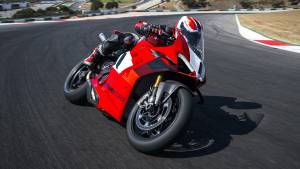All-new Ducati Panigale V4: How it was made?
Ducati pulled the wraps off its most anticipated offering, the Panigale V4 at the EICMA before the EICMA 2017. The all-new Ducati Panigale V4 is the brand's first first production four-cylinder motorcycle to arrive from the Ducati factory at Borgo Panigale. We did get a glimpse of the MotoGP-inspired Ducati V4 superbike few weeks ago, revealing some bits on the design. There's so much technology and so many new ideas that understanding the Ducati Panigale V4 can be a challenge. But here's the essential things you need to know
 Why a V4?
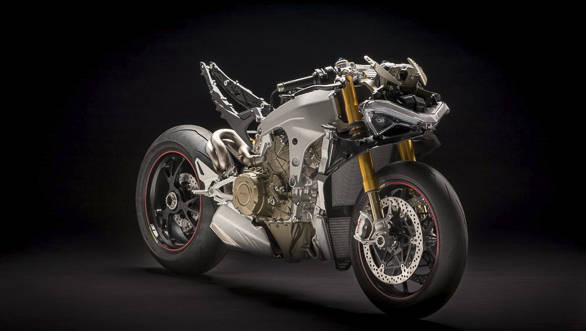 The addition of two-cylinders makes the motor of the 2018 Ducati Panigale V4 heavier than 1,285 cc unit by 2.2kg, while the kerb weight has gone up by 5.5kg
The addition of two-cylinders makes the motor of the 2018 Ducati Panigale V4 heavier than 1,285 cc unit by 2.2kg, while the kerb weight has gone up by 5.5kg
Ducati's valiant twin-cylinder has limits. The 90° V4 was the natural place to go. It retains most of the natural advantages of the L-twin but brings extra cylinders that Ducati needs to stay at the forefront of the 220PS sportsbike game.
The Desmosedici GP V4
The idea to keep the bore the same as the MotoGP racebike appears to have been accepted very early. Ducati plays the stroke to get the 1,199cc displacement. The 81mm bore also means that the fluid dynamics of the engine head can be drafted in in from the MotoGP racebike - very similar but not identical. Ducati did narrow the valve angle more and create skinny spark plugs along the way to allow big valves to sit at the narrow included angle. The head, with two cylinders is barely 5cm wider than the SuperQuadro's head cover while the new engine is wider by 4-5cm at its widest part. It is also less tall than the SuperQuadro and just 2.2kg heavier than the twin at 64.9kg.
The super twin
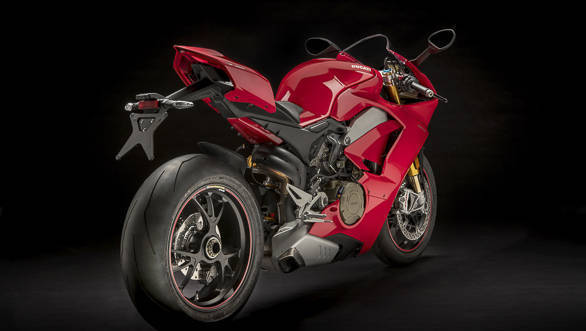
The engine firing order is pretty similar to a twin cylinder's. The first cylinder fires at 0° - the front left. 90° later, the rear left cylinder fires. Two combustion events clustered together. Then there's a break. At 290° the right front cylinder fires and 90° later the rear right cylinder completes the cycle. Ducati calls this firing order Twin Pulse and it's said to bring the sound close to the MotoGP motorcycle's.
Counter-rotating crankshaft
The MotoGP bikes use crankshafts that rotate backwards to cancel some of the gyroscopic inertia of the wheels. Ducati uses the same idea â" it cuts the tendency to wheelie on acceleration as well as to lift the rear wheel on the brakes.
Variable intake system
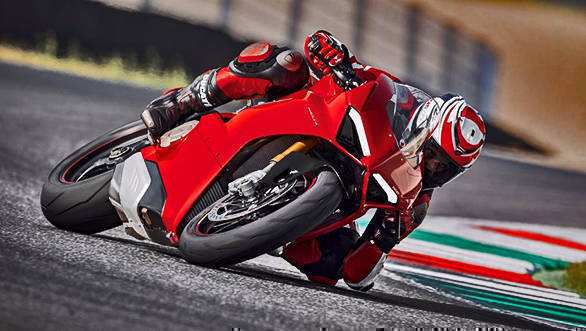
Between the cylinder banks sit intake funnels, short stubby trumpets. Ducati adds a second set that sits on top increasing the duct length. The ECU determines when to lift the secondary duct set and shorten the intake path - beneficial at high revs. The long intake is used up to 9,500rpm and then every 1,000rpm, the configuration switches, four times in all, before the short intakes run to the redline. Ducati says this optimises pressure waves and helps the torque curve stay high and flat for longer. Over 100Nm is available steadily from about 7,000 to over 13,000rpm which Ducati says should make the V4 a good street bike.
Lubrication
Ducati uses a semi-dry sump lubrication system with a deep, narrow bottom to ensure that extreme acceleration doesn't starve the engine of oil. The compact quartet of pumps is little more than a Coke can! This bolts below the starter motor under the front cylinder bank.
6-speed gearbox
An 11-plate slipper clutch and a 6-speed gearbox is the transmission. Ducati has added more sensors so that the standard up and down quickshifter can determine the position of the shift drum and shift forks to precisely time gearchanges. And the DQS now uses lean angle data to ensure smooth shifts.
Desmo service
Ducati cheekily reminds you that the Panigale V4 is a regular street bike with major service with valve clearance inspections a full 24,000km apart.
The engine position and the front frame
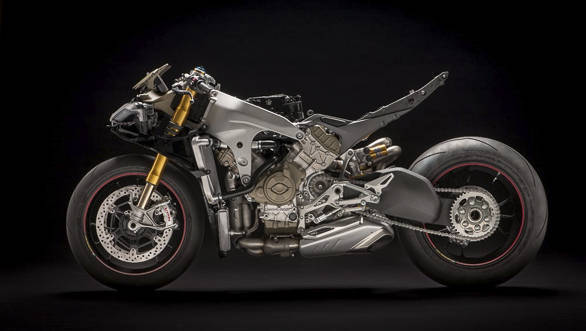 The chassis of the all-new Ducati Panigale V4 comes with a new frame that bolts on the front and rear cylinder heads while the swingarm mounts on the back of the engine casing.
The chassis of the all-new Ducati Panigale V4 comes with a new frame that bolts on the front and rear cylinder heads while the swingarm mounts on the back of the engine casing.
Ducati uses the new V4 canted backwards 42° and sets the engine more forward in the frame. The engine is the stressed member and the headstock sits in the new cast aluminium Front Frame, a half twin-spar frame. The front prongs connect to the top of the crankcase - longer arms allow more flex, good for cornering - while the rear of the spar bolts to the rear cylinder head.
600mm single-sided swingarm
The engine position permits a enormously long swingarm - Ducati says it is the longest in the business. Ducati also let slip that the Panigale V4 swingarm is a big step forward and the 'box' like section right after the swingarm pivot is part of the design
for controlled flex.
Wheels, tyres and brakes
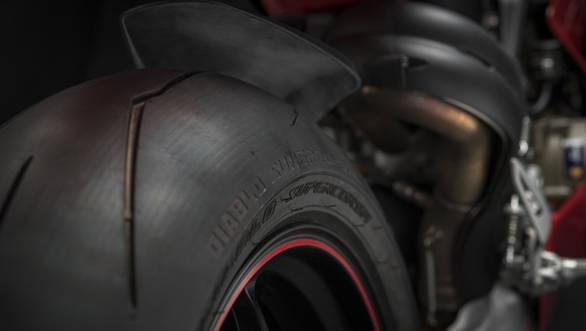
The brakes are the latest Stylema (sti-ley-ma) from Brembo that superseded the M50. They offer the same stiffness but are 50g lighter each. Marchesini supplies the super light wheels including the optional 1kg lighter magnesium ones for the Speciale. The tyres are new Pirelli Supercorsas that use a new 200/60 section that increases cornering contact patch.
Electronics
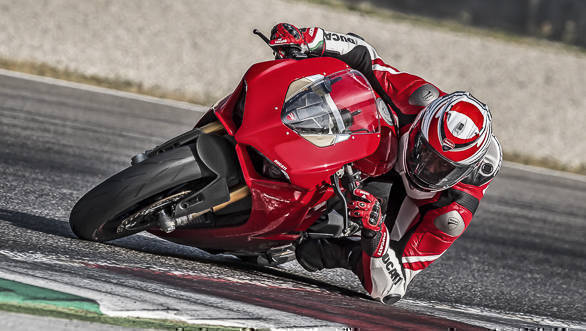
Ducati says the Black Box or BBS makes all decisions based on the Bosch 6D Inertial Measurement Unit's input. The DQS and the Engine Brake Control now use lean angle data. Launch control uses it in both the stages - clutch in play and after the clutch has been released. Ducati Slide Control Evo allows safety net equipped control of slides in the middle of the corner while Traction Control Evo's modes 1-2 (expert modes) allow you to deploy more (or less) wheelspin to change the cornering line you're using. The essential advantage on the V4, they say is that the systems intervene quicker and more softly so that the 'oscillations' between the bike going out of control and returning to full control are smaller. The flip side, of course, is that most of these systems are multi-level adjustable which means you will be spending a lot of time finding settings that work for you.
The human-machine interface
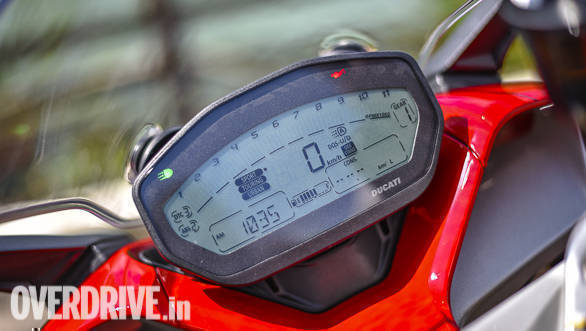 The Ducati SuperSport's instrument cluster looks similar to the Monster 821 and 959 Panigale's and incorporates a lot of information in a neat, legible manner
The Ducati SuperSport's instrument cluster looks similar to the Monster 821 and 959 Panigale's and incorporates a lot of information in a neat, legible manner
The new 5" TFT screen uses new graphics that promise to be clearer. But more important, Multistrada style switch cubes promise a cleaner, faster interaction.
Model spread
The base V4 has all of this equipment. But the bike that will sell the most will be the V4 S. That switches from the Showa Big Piston Forks to Ohlins' new Smart EC 2.0 electronic forks and rear suspension. The 6kg lighted Speciale adds a sprinkling of carbon fibre and a full Akrapovic system that takes power from 214 to 226PS.
The Ohlins Smart EC 2.0
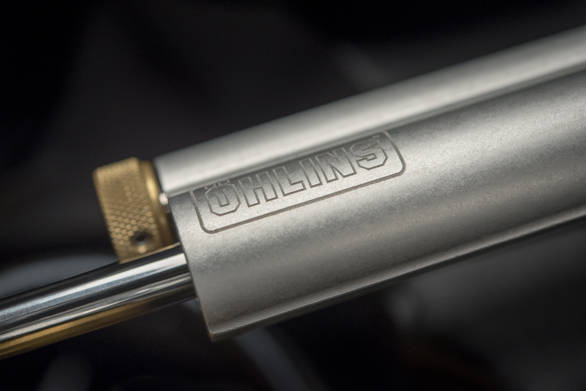
The Ohlins units are electronically controlled. In Manual mode, you can fix compression, rebound and preload parameters. In Automatic, the default, the suspension ECU reacts rapidly to your riding style. Straight line, braking, turning, mid-corner and exits are all riding events and you can tell the Smart EC 2.0 what you would like it to do for each scenario. Each event control is a slider where you decide between performance or stability. It also means each rider will, for the same setting, feel a slightly different machine in setup as the suspension adapts to their inputs within the agility-stability parameter selection.

